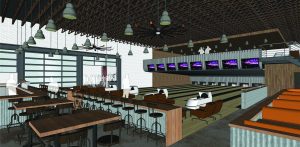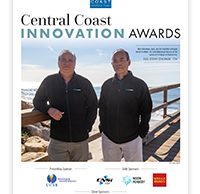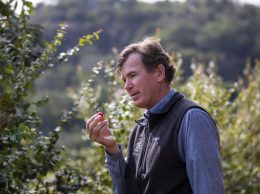Twin brothers Josh and Jeremy Pemberton are planning to expand their Ventura-based food and entertainment business to San Luis Obispo.
The two own and operate Discovery Venues, and in late March, they submitted plans to redevelop the 24,500-square-foot former Sports Authority building at 1144 Chorro St. in San Luis Obispo into a 14-lane bowling alley, restaurant and live music venue.
The roughly $5 million project is slated to go before the SLO Planning Commission in June. If all goes as planned, Discovery SLO could open its doors in late 2015; however, a spring 2016 opening is more likely. The company hopes to have building permits in hand by September and is driving hard for a 2015 launch, said Jeremy Pemberton. Santa Barbara-based architecture firm AB Design Studio is designing the project.
In 2013, the brothers launched their first concept, Discovery Ventura, a nine-lane bowling, food and live music venue at 1888 E. Thompson Blvd. in Ventura. Prior to that, the pair was responsible for putting together the West Beach Festival in Santa Barbara. At one point, the headcount at the festival reached about 33,000 people. Business was going well for the newly formed Twiin Productions, the company
Pembertons formed fresh out of college. However, in 2010, changes in city policy forced the event to move, cut out a full day of programming, increase fees and limit beer sales, Josh told the Business Times in an email.
“We had to close the business that was the namesake of our identity, and it hurt a lot of vendors around town,” he said in the email. “We ended up selling our personal valuables to scrap together enough cash to purchase a 19-foot 1974 Shasta trailer and lived on the road for the next nine months, writing the business plan for Discovery.”
The West Beach festival was the learning experience the brothers needed to get wiser about establishing their next venture. The company raised $2.8 million for the Ventura location and restored what was already a bowling alley into a contemporary entertainment venue. The 14,500-square-foot building was built during World War II and was originally an A&P store. To help get the project off the ground, the brothers pooled almost 30 investors and secured a $125,000 loan from the city of Ventura for facade improvements, ADA-compliance upgrades and working capital needs.
Josh admits they made some mistakes early on, including underestimating start-up costs, but he said the location is now on pace to do $2 million in sales this year.
For the SLO project, Josh and Jeremy have already enlisted the help of some experienced partners, including the property owner Atlanta-based real estate firm Jamestown and longtime developers Tom and Jim Copeland, co-owners of SLO-based Copeland Properties.
In 2013, Jamestown purchased $100.5 million in commercial property in San Luis Obispo from the Copeland brothers in exchange for assuming $50 million in debt and $50.5 million in ownership of Jamestown properties. Copeland continue to manage the properties, which include Court Street Centre and the Downtown Centre. In exchange for the sale, the Copelands were given a stake in Jamestown’s Premiere Property Fund, which includes real estate in New York, San Francisco and Washington, D.C. The property slated for the new Discovery location was also part of that deal.
It’s the market opportunity in SLO, which doesn’t have a bowling alley, the central downtown location and the combination of new retail development from Copeland’s Chinatown project that made the Discovery project an attractive investment for all those involved, Jeremy said. Jamestown and Copeland are mocking “substantial tenant allowances and providing about half of the project’s development cost,” he added. “Partnering with Jamestown, a $7 billion company, is a ridiculous opportunity.”
After visiting the Ventura Discovery location, it was Copeland who offered the deal. The company expects to do about three times the sales of the Ventura location in SLO.
For their part, Josh and Jeremy have raised about 40 percent of the funds they need to get the project started. Going forward, Jeremy said the company has completed a market analysis on 20 different cities where they could potentially take the concept next.
“We know where we want to go and we have the playbook,” he said. “But we’re going to take our time here with SLO and hopefully bring in some more institutional financing and scale this model up in a pretty cool way.”






 Print
Print Email
Email


















